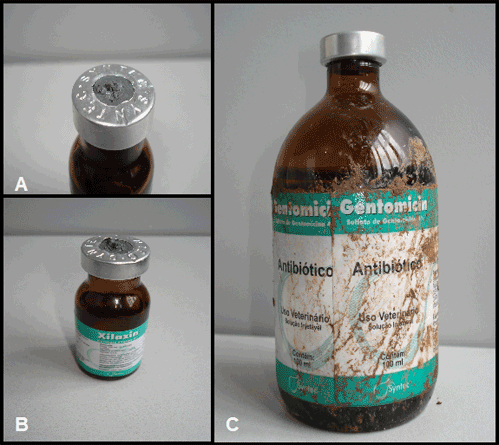Neste Blog realizamos: 1 - Atualização sobre SAÚDE PÚBLICA, PESQUISA BIOMÉDICA E BIOSSEGURANÇA. 2 - Atualização sobre a ocorrência de Doenças de importância em animais de laboratório e outras espécies. 3 - Troca de Informações sobre Doenças Infecciosas, Zoonoses, Licenciamento Ambiental, Defesa Sanitária Animal, Vigilância Sanitária, Boas Práticas de Laboratório e demais assuntos relacionados à sanidade e Saúde Pública.
Pesquisar Neste Blog
quarta-feira, 22 de dezembro de 2010
Boas práticas na aplicação de medicamentos
 André Maciel Crespilho André Maciel CrespilhoMédico veterinário, Doutor em Reprodução Animal pela FMVZ-UNESP, Botucatu/SP, coordenador de pesquisa clínica da Syntec do Brasil, Ltda |
Na atualidade, um grande destaque tem sido atribuído as chamadas Boas Práticas de Manufatura (BPM), uma tradução da consagrada sigla GMP (Good Manufacturing Practices) extraída da língua inglesa. As BPMs abrangem um conjunto de medidas adotadas por indústrias dos mais variados seguimentos, como as empresas de alimentos ou de medicamentos veterinários, a fim de garantir a qualidade sanitária e a conformidade dos produtos que chegam ao mercado consumidor.
No entanto, em nosso dia a dia temos observado uma crescente necessidade por uniformização não apenas de produtos industrializados, como também na prestação de serviços e elaboração de atividades técnicas como, por exemplo, na gestão de uma fazenda ou empresa rural. No caso de uma corriqueira aplicação de medicamento ocorre a mesma situação. Para que um remédio atue de maneira adequada, exercendo o seu efeito biológico, alguns cuidados essenciais devem ser tomados. A observação e padronização desses cuidados representam o que podemos chamar de Boas Práticas na Aplicação de Medicamentos (BPAMs).
Nesse sentido, o objetivo dessa matéria é apresentar alguns dos cuidados básicos que técnicos e pecuaristas devem tomar durante a aplicação de medicamentos para ovinos e caprinos, garantindo a máxima eficiência dos produtos e menor ocorrência de efeitos colaterais.
Vias de aplicação
O primeiro passo para a utilização racional de um fármaco representa a pesagem dos animais. Como a dose de cada medicamento varia de acordo com o peso do animal, a pesagem representa a primeira medida de BPAMs a ser instituída para garantir o sucesso dos protocolos terapêuticos.
Estabelecida a quantidade de medicamento a ser aplicado, 2 vias principais de administração podem ser consideradas: oral ou parenteral, essa última, por sua vez, inclui a via subcutânea, intramuscular e intravenosa.
A via oral (PO) é de grande utilidade especialmente para administração de anti-helmínticos para ovinos e caprinos. Geralmente são utilizadas pistolas dosadoras de metal, que permitem uma correta calibração do volume a ser administrado.
A via subcutânea (SC) consiste na deposição de um medicamento entre a pele e o tecido muscular subjacente. Para esta via geralmente se elegem as regiões da tábua do pescoço ou subescapular por possuírem a pele mais solta.
A rota intramuscular (IM) compreende a deposição de medicamentos diretamente na massa muscular, aproveitando a grande perfusão sanguínea presente nos músculos para promover uma rápida absorção. Para utilização dessa via devemos preferir a musculatura da região do pescoço em relação às regiões de carnes nobres, como o pernil e a paleta. A utilização de substância irritante por essa via pode resultar em necrose muscular, devendo, portanto, ser evitada.
Medicações intravenosas (IV) podem ser feitas em veias superficiais como a jugular direita ou esquerda, apresentando como maior vantagem em relação à todas as outras rotas o início de efeito terapêutico de forma imediata e a possibilidade de infusão de grandes volumes de medicamento de uma só vez (WEBSTER, 2001).
Qualidade e procedência dos produtos
A produção de medicamentos veterinários atende as normas de BPM definidas para a indústria farmacêutica, que garantem a qualidade, eficácia e segurança dos produtos. No entanto, existe um longo trajeto entre a produção de um medicamento até sua chegada para o uso na propriedade. Após a produção, o medicamento será embalado, transportado e estocado nas lojas ou distribuidoras seguindo, posteriormente, para as propriedades onde muitas vezes serão armazenados em condições inadequadas. É durante esse trajeto que ocorrem grande parte dos problemas que podem comprometer a eficácia de um medicamento.
Por essa razão, para obtermos a máxima eficiência do produto, nunca devemos utilizar medicamentos:
- Que não tragam na embalagem ou no próprio frasco, o número de registro no Ministério da Agricultura e nome do responsável técnico pela fabricação. Embora muitas formulações caseiras (especialmente aquelas baseadas na cultura popular) apresentem algum benefício terapêutico, tal prática deve ser evitada, pois na grande maioria das vezes não existem dados conclusivos não apenas sobre a eficácia terapêutica das formulações, como também dos efeitos tóxicos relacionados à sua utilização.
- Que estejam fora do prazo de validade.
- Nunca utilizar medicamentos que apresentem a embalagem falsificada, adulterada, violada ou com sinais de má armazenagem, como frascos danificados, sujos ou molhados (Figura 1).
- Todo medicamento deve possuir uma bula para orientação de uso. A falta dessas informações representa motivo para a recusa ou devolução de um medicamento.
Figura 1 - Exemplos comuns de má utilização e conservação de medicamentos. A e B: Detalhe da excessiva perfuração da "borracha" do agente anestésico Xilazin®, expondo o conteúdo do medicamento à contaminação externa. C: Detalhe do frasco de antibiótico de amplo espectro Gentomicin®, armazenado sem nenhuma condição de higiene no próprio curral de manejo animal.

Cuidados fundamentais durante a aplicação de medicamentos
Algumas regras simples de Boas Práticas na Aplicação de Medicamentos podem ser consideradas para obtenção dos melhores resultados durante a realização de um protocolo terapêutico em pequenos ruminantes:
- Sempre utilizar seringas e agulhas descartáveis para aplicação de antibióticos e anti-inflamatórios.
- Caso se utilizem seringas de metal, deve-se proceder a fervura das agulhas como método de esterilização, realizando-se a troca sistemática a cada 10 animais tratados. Preconiza-se ainda a adequação do calibre das agulhas (agulhas para ovinos e caprinos não precisam ser tão calibrosas quanto às utilizadas para bovinos) e o descarte daquelas que se apresentarem em más condições (agulhas tortas, sem fio ou enferrujadas).
- No caso da aplicação de medicamentos orais, deve-se verificar a limpeza e calibração das pistolas dosificadoras previamente ao uso, que devem ser sistematicamente re-calibradas a cada 10 animais tratados. O aparelho dosificador deve ser utilizado com bastante cautela e por uma equipe especializada, evitando-se a ocorrência de possíveis traumatismos na boca de ovinos e caprinos. Lesões causadas por aparelhos dosificadores podem levar a formação de abscessos orofaríngeos e fístulas submandibulares que evoluem para anorexia, depressão, septicemia, e em alguns casos, para a morte dos animais (RIET-CORREA, 2001).
- Tratamentos que envolvam grandes lotes, ou até mesmo todo o rebanho, devem ser realizados nas horas mais frescas do dia (início da manhã ou final da tarde) para diminuição do estresse.
- O local de aplicação dos produtos deve ser higienizado através de algodão ou gaze, embebidos em soluções antissépticas.
- Sempre respeitar as informações e indicações apresentadas nas bulas dos medicamentos. Cada fármaco possui uma recomendação própria quanto a via de aplicação. Sendo assim, nunca aplicar um medicamento destinado exclusivamente à via intravenosa através da via subcutânea, por exemplo.
De acordo com Vechiato e Maciel (2009), aplicações mal feitas de medicamentos causam edemas, abscessos e até lesão de nervos no local de aplicação, levando a dor, queda no consumo de alimento e ganho de peso diário.
Nesse sentido, a adoção de Boas Práticas de Aplicação de Medicamentos torna-se fundamental não apenas para o sucesso dos protocolos terapêuticos, como também para a prevenção de problemas decorrentes da má utilização dos fármacos. Através de medidas simples como boa armazenagem de produtos, higienização do local de aplicação e troca frequente de agulhas se começa um efetivo sistema de controle sanitário de um rebanho. Conforme ressaltado no trabalho de Vechiato e Maciel (2009), animal saudável é lucro certo na propriedade!!!
Referências bibliográficas
BELLUZO, C.E.C., KANETO, C.N., FERREIRA, G.M. Vias de aplicação de medicamentos. In... Curso de Atualização em Ovinocultura, UNESP - Curso de Medicina Veterinária, Departamento de Apoio, Produção e Saúde Animal, Araçatuba/SP, 2001. p.84-88.
RIET-CORREA, F. Lesões bucais e retrofaríngeas causadas por aparelhos de dosificar. In...Doenças de Ruminantes e Eqüinos, 2001. Ed.2. Varela: São Paulo, 2001.
VECHIATO, T.A.F., MACIEL, R.A.P. Cuidados fundamentais durante a aplicação de medicamentos. BeefPoint: Radar Técnico em Sanidade Animal, 21/05/2009. Acesso em 08/12/2010.
WEBSTER, C.R.L. Farmacologia Básica: Absorção de Drogas. In...Farmacologia Clínica em Medicina Veterinária. Ed.1. Roca: São Paulo/SP, 2005. p.1-2.
Postado por
SHDA_CECAL FIOCRUZ
às
14:33
0
comentários


Enviar por e-mailPostar no blog!Compartilhar no XCompartilhar no FacebookCompartilhar com o Pinterest
Georgia dog with rare throat defect receives laser surgery

|
- Georgia dog with rare throat defect receives laser surgery
Lucy, a 6-year-old dachshund in Georgia, recently underwent laser surgery to treat a rare defect on its throat called reflex achalasia. Lucy reportedly is recovering and is the second dog in the U.S. to receive the treatment, which involves less scarring. The Sacramento Bee (Calif.) (free registration) (12/22)
- Study: Raccoon outhouses can pose disease risk in humans
A study published in the Emerging Infectious Diseases journal indicated that humans, particularly children, are at risk of contracting a fatal parasitic roundworm called Baylisascaris procyonis when they encounter raccoon latrines, or sites that the critters repeatedly use to defecate. Researchers said using medicated bait for the raccoons and sterilizing latrines can help control the spread of the parasite, which can lead to permanent neurological damage, blindness or even death. LiveScience.com (12/21)
- Other News
- Florida county health department issues rabies alert
WJXT-TV (Jacksonville, Fla.) (12/20)
 | Do People Trust Your Brand? Business-to-Business companies increasingly recognize how critical building trusted online relationships has become to their financial success. Download this white paper to learn how companies can align trust, credibility, and privacy processes within their organizations to grow revenues and mitigate risk. |
|
- Miss. shelter sees rise in surrendered pets amid tight economy
A shelter in southern Mississippi has reported taking in 3,617 pets so far this year, driven by a rise in the number of in-state owners who have experienced loss of jobs or homes as a result of the recession. USA TODAY/The Associated Press (12/21)
- Florida reports panther attacks on domestic animals
The Fish and Wildlife Conservation Commission in Florida reported that a pig and several goats in the state have died this month after being attacked by endangered panthers. The agency is advising in-state residents to keep their livestock in enclosed facilities and domestic pets indoors, especially at night. ABC News/Reuters Life! (12/20)
- Researchers use mice to help shed light on human language origins
Earlier studies have shown that birds use various sound elements that they organize into chunks before turning them into "songs." Now, Japanese researchers said they have created bioengineered mice that tweet like birds and could offer better clues to the evolution of human languages. "Mice are better than birds to study because they are mammals and much closer to humans in their brain structures and other biological aspects," the lead researcher said. Google/Agence France-Presse (12/21)
 | Discover the keys to a vibrant corporate culture Creating & sustaining a vibrant corporate culture takes strong leadership and transparency. GM's Mark Reuss shares insights into rebuilding a company's culture. DeLisa Alexander offers best practices from Red Hat's opensource culture. SmartBrief readers receive executive training for just $75. |
|
- 5 ways to breathe life into your business
Has your business hit a plateau or have you run out of ideas to help it expand? Try taking a hard look at your financials to evaluate ways to improve, advises Connie Edwards. Also take the time to find the right employees and develop creative incentive programs to keep customers engaged. Savannah Morning News (Ga.) (free registration) (12/20)
 | 2011 planning for social media made simpler 94.1% of businesses use social media to build brand awareness — does yours? Get insights into business trends and best practices for social media fromSmartBrief's State of Social Media for Business. Make your 2011 social-media strategy count with data from 6000+ business execs. Download the key takeaways now. |
|
- House approves food safety bill
The House passed a food safety bill 215-144, setting the stage for President Barack Obama to sign it into law. Food processors will be required to develop safety plans and government officials will have more enforcement power under the law, which aims to prevent outbreaks of food-borne illness. The Washington Post (12/22) , The New York Times (free registration)(12/21)
- U.S. states increasingly adopt dog-breeding laws
Laws that set restrictions on dog breeders have been adopted in recent years by several U.S. states, including Oklahoma and Missouri. Almost 5,000 breeders across the country are licensed by the Department of Agriculture, but thousands more are unregulated such as those that sell puppies online, according to this article. The Wall Street Journal (12/20)
- Ohio's first livestock-care standards are slated for review
An Ohio panel is set to consider today euthanasia guidelines and civil penalties recently approved by the state's Livestock Care Standards Board. Groups such as the Ohio Farm Bureau Federation have aired concerns over some blurring of the distinction between the authority of county officials and the board in setting up livestock-care standards and determining civil penalties, among other issues. Farm and Dairy (Salem, Ohio) (12/21)
- Other News
- Oklahoma bill seeks to overturn pet breeders law
Feedstuffs (Minnetonka, Minn.) (12/22)
 | "Healthy Eating: A guide to the new nutrition" —A special report from the experts at Harvard Medical School helps you understand which foods help you prevent disease and which ones put you on a collision course. 30% off and free shipping for SmartBrief readers. Click here to order Healthy Eating. Now available in hard copy or electronic download. |
|
- Georgia veterinary program obtains AVMA accreditation
Fort Valley State University in Georgia announced that its veterinary science program has earned full accreditation from AVMA, after a two-year process. The accreditation enables students enrolled in the program to take the licensing exam for veterinary technicians, according to this article. The Macon Telegraph (Ga.) (12/22)
|  |
|
- Comments sought on veterinary education
The North American Veterinary Medical Education Consortium wants to hear your thoughts about how we can create a workforce of future veterinarians who are prepared to address society's needs. The draft AAVMC report and recommendations on the future of veterinary medicine can be found at www.navmec.org, where you can also submit your comments. For more information you can participate in a series of webinars detailing the report and the recommendations contained therein.
Postado por
SHDA_CECAL FIOCRUZ
às
14:13
0
comentários


Enviar por e-mailPostar no blog!Compartilhar no XCompartilhar no FacebookCompartilhar com o Pinterest
Genetic Analysis Points the Way to Individualized PSA Tests
In cancer research, one never-ending quest is the hunt for biomarkers, proteins in the blood that reveal tumors deep in the body. The goal is to find a reliable predictor that enables early diagnosis and better treatment of disease. Most biomarkers identified so far have been disappointing, but millions of men are tested for one of them: PSA, or prostate-specific antigen, which cells in the prostate gland churn out at higher levels when cancer is present.
But some men with high PSA levels don't have the disease, leading to unnecessary biopsies, and some with low PSA levels do. PSA testing is routine in some places, yet large clinical trials in the United States and Europe are questioning how big an impact it has on reducing cancer deaths. This week, a group in Iceland suggests a new way to assess PSA results: Acknowledge that under normal circumstances some men produce more (and some produce less) PSA, and individualize healthy and high levels for each man tested by focusing on genetic variants that affect PSA levels.
“Let's say that a PSA level of 4 is considered worrisome,” says William Catalona of Northwestern University Feinberg School of Medicine in Chicago, Illinois. He developed the original PSA test and is a co-author of the new work, published in Science Translational Medicine. “You might be able to take something like a tongue depressor and scrape a man's cheek,” and with DNA testing “you might find out this man is a high PSA secretor” normally, reducing concern.
Adjustable baseline.
A man's genes affect normal PSA levels. The border marking the danger zone for cancer risk (dotted line) may shift, depending on an individual's DNA.
The researchers on the PSA study, led by geneticists Julius Gudmundsson and Kari Stefansson of deCODE Genetics in Reykjavik, began by scanning the genomes of about 16,000 men to identify places in the genome that modify the PSA level in blood. They found six, including three that were previously identified. Then the group compared more than 5000 men with prostate cancer and 41,000 without. They assessed whether variants at the six sites modified PSA and prostate cancer risk. Although it's difficult to disentangle genetic effects on PSA levels from those on prostate cancer risk, the researchers concluded that two of the variants influenced only PSA levels and two others had only a marginal effect on cancer, making all four useful for testing.
PSA levels for the men in the study varied widely. The key was whether genetic analysis would shift the men into different categories—for example, whether a man whose PSA level might merit a prostate biopsy would escape biopsy once his genes were taken into account. The numbers here were modest: About 6% had their PSA measurement reclassified as either safe or unsafe based on their genetics. “Basically what we're talking about is changing the parameters of detection of disease,” says Richard Hayes, an epidemiologist at New York University who has studied some of these gene variants. In theory, the approach could be applied to biomarkers for other cancers, too, making them more precise and more clinically useful.
The study looked back in time, so the genes didn't influence health care decisions. And Hayes and others agree that although the concept of using genetics to make PSA tests more meaningful holds promise, these specific variants aren't ready for prime time. The finding “is a good start, but it's not sufficient to introduce this extensive genetic screening to everybody,” says Fritz Schröder, a urologist at Erasmus Medical Center in Rotterdam, the Netherlands.
A valid gene-based PSA analysis could help, Stefansson claims, by, for example, enabling some men with high PSA results to avoid a biopsy. But genetic analysis cannot yet be used to tackle a different puzzle: Many men with high PSA results do have cancer but an “indolent” form that grows so slowly that it's unlikely to kill them if left untreated.
There is currently no way to distinguish the men at high risk of dying from their prostate cancer from those with a minimal risk of dying. The deCODE study didn't examine whether adding genetics to the mix could help reduce mortality. The deCODE group and others now need to examine “how many people they can help,” says Stacy Loeb, chief resident in urology at Johns Hopkins University in Baltimore, Maryland, who has studied PSA genetics.
Two large U.S. and European clinical trials underscore this need. Both trials randomly assigned tens of thousands of men to get regular PSA testing, or not, and then followed them to see who developed prostate cancer and who died of it. Last year in The New England Journal of Medicine, the U.S. study reported no difference in mortality between the group that had regular PSA screening and the one that did not. The European team, led by Schröder, found that those who got PSA screening were 20% more likely to survive prostate cancer. Schröder attributes the contrasting results to different study designs; both groups are continuing to follow the men.
Meanwhile, PSA testing is in flux. Earlier this month, a cancer screening committee in the United Kingdom advised against routine PSA testing, citing concerns about overdiagnosis of slow-moving cancers. In other European countries, the popularity of PSA testing varies, says Schröder. It remains routine in the United States.
“I'm reluctant to make any predictions” about how PSA genetics might help guide early detection of prostate cancer, says Stephen Chanock, chief of the laboratory of translational genomics at the National Cancer Institute in Bethesda, Maryland, who works in this area. While he commends the deCODE group for pushing the ball forward, he says, “one really would want to see further confirmation and precision” in the number of men affected by these gene variants and the effect each variant has on PSA.
Postado por
SHDA_CECAL FIOCRUZ
às
13:58
0
comentários


Enviar por e-mailPostar no blog!Compartilhar no XCompartilhar no FacebookCompartilhar com o Pinterest
Assinar:
Comentários (Atom)







